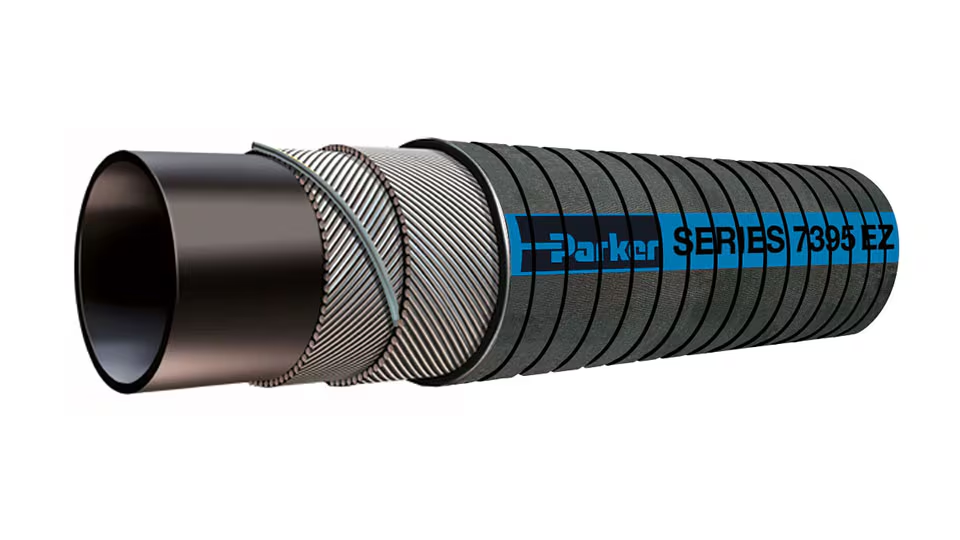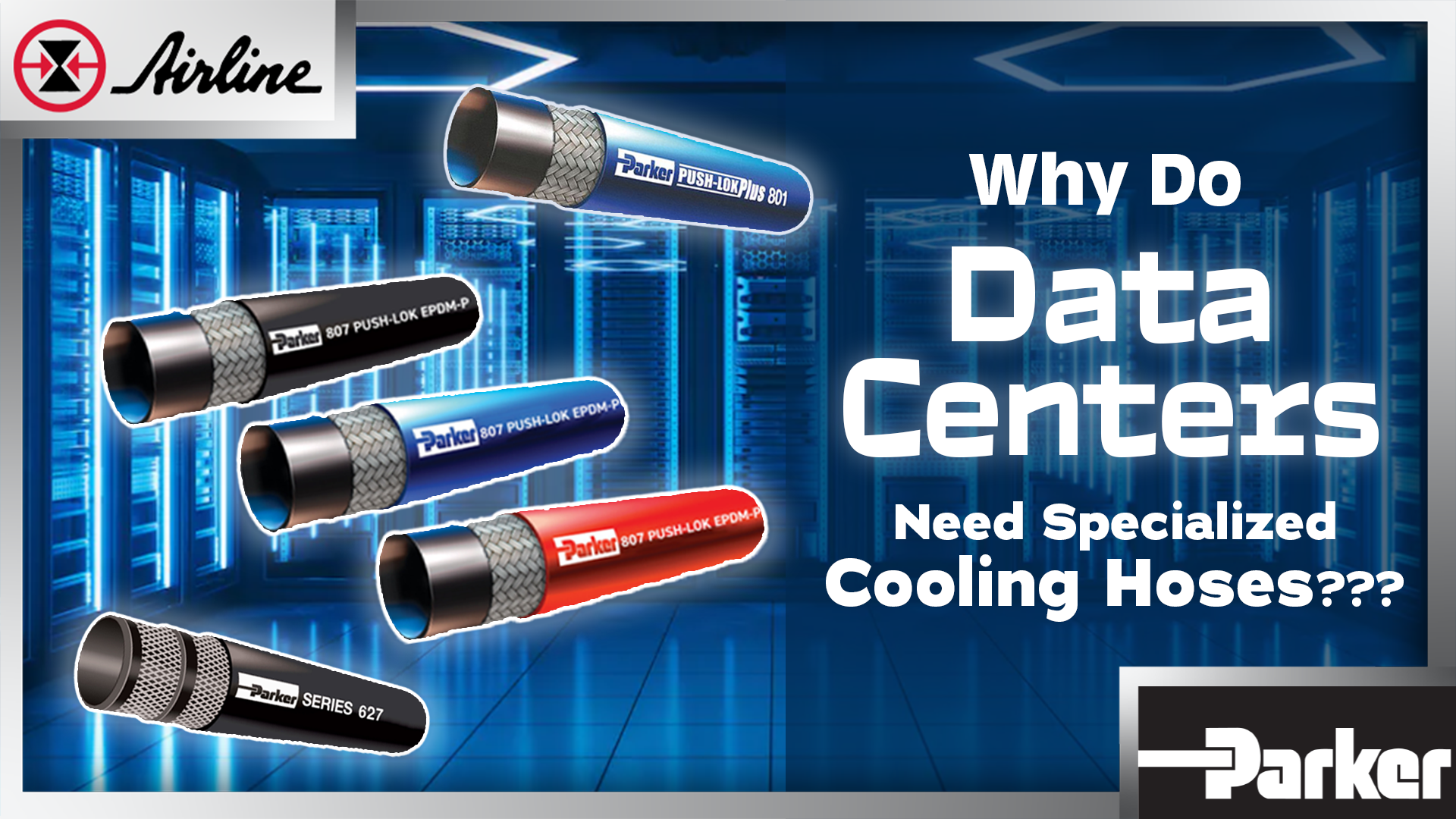As artificial intelligence (AI) adoption continues to accelerate, the demand for data centers and precise cooling has never been higher. These facilities run nonstop, generating an enormous amount of heat and requiring flawless cooling to prevent costly downtime and protect critical operations.
Because of this, liquid cooling is rapidly replacing traditional air methods for its superior heat transfer, but this process brings new challenges. Pumps, hoses, and fluid power components are now mission-critical, and a single failed hose can halt operations, breach service-level agreements (SLA), and damage reputations. Tight spaces, high flow rates, and constant cycle stress put hoses to the test.
That’s why data centers need more than standard hoses. Purpose-built solutions, like those from Parker, offer advanced designs and materials engineered to withstand extreme conditions, reduce failures, and ensure reliability.
In this article, I'd like to point out how liquid cooling is reshaping data centers and why specialized hoses are essential for flawless performance.
Skip to a Section
Liquid Cooling for Data Centers | Why Standard Hoses Fail |
Parker Technologies Data Center Cooling | Additional Resources
See How Different Cooling Hoses Perform Under Real Conditions:
Liquid Cooling for Data Centers
During a conversation with Power & Motion Tech and Joe Chopek, Business Development Manager, Fluid Connectors Group at Parker, it was stated that as data centers grow in size and computing power, especially with chips now reaching 200 kW and beyond, traditional air cooling methods can no longer keep up. Above roughly 150 kW, it’s simply not possible to move enough air to remove the heat effectively. This has led many facilities to adopt liquid cooling, a far more efficient way to manage extreme heat loads.
Liquid cooling systems pump a water-glycol solution directly to the heat-generating components, such as chips, to absorb and transfer heat away. According to Power & Motion Tech, this approach can achieve 20–30% greater efficiency compared to air cooling, lowering electricity use and the total cost of ownership. Considering that electricity accounts for about 80% of a data center’s operating costs, those savings are significant.
At the heart of these systems is a fluid conveyance network made up of hoses, fittings, thermoplastic tubing, pumps, manifolds, quick couplings, connectors, and filters. Some of Parker’s specialized hoses, for example, enable direct-to-chip cooling to ensure components stay within safe operating temperatures, helping prevent performance drops, downtime, and damage.

By drawing heat away more efficiently, liquid cooling not only supports higher power loads but also helps data centers run more sustainably.
Why Standard Hoses Fail in Data Center Cooling
 Data center cooling systems operate under extreme and continuous conditions that quickly expose the weaknesses of standard hoses. While these hoses may perform adequately in less demanding applications, the unique stresses of data centers can cause premature failure.
Data center cooling systems operate under extreme and continuous conditions that quickly expose the weaknesses of standard hoses. While these hoses may perform adequately in less demanding applications, the unique stresses of data centers can cause premature failure.
Understanding the main reasons hoses fail helps highlight why specialized hose technologies are critical to maintaining uptime and protecting expensive equipment.
1. Material Degradation
Thermal Cycling Breakdown
Standard rubber and low-grade hoses in data centers face constant thermal cycling as systems run 24/7. Repeated heating and cooling cause these materials to expand, contract, and eventually crack or soften.
A common but often overlooked failure mode is electrochemical degradation (ECD), where different metals in the cooling system induce micro-cracks inside the hose. Hoses affected by ECD often feel soft or spongy near the ends, signs of internal breakdown that typically go unnoticed until leaks occur.
Chemical Compatibility Issues
Coolants, additives, and cleaning agents used in advanced cooling systems may react negatively with hose materials. Chemical incompatibility causes swelling, brittleness, inner layer breakdown, and eventual leaks or ruptures.
Compared to conventional rubber hoses, silicone and EPDM hoses offer superior resistance, maintaining integrity under harsh chemical exposures common in data centers.
2. Performance Issues
Reduced Flow Due to Internal Degradation
Inferior hose materials may swell or collapse internally after long-term exposure to pressure and chemicals. This restricts coolant flow, causing uneven cooling, localized hotspots, and reduced overall system efficiency.
Even small blockages near critical chips can cause overheating, risking catastrophic failure in liquid-cooled racks.
Leaks and Overheating
Leaks from pinholes, ruptures, or failed connections don’t just lead to coolant loss; they cause localized overheating of vital components.
In data centers, minor leaks can escalate into major failures, triggering emergency shutdowns and risking costly downtime and data loss. Burst hoses near fittings often result from degraded materials or improper assembly.
3. Costly Failures
Direct Repair Costs
Emergency hose failures require urgent repairs, including:
- Expedited hose replacements
- Cleanup of spilled coolants
- Replacement of hardware damaged by leaks
Indirect Costs
- Downtime is extremely expensive. Every hour of lost operation can cost six figures due to missed SLAs and production losses.
- Data loss and irreversible damage to servers create risks that far exceed those replacement expenses.
- Regulatory fines or higher insurance premiums may also follow environmental leaks or compliance violations.
These risks of failure highlight the need for custom, high-quality cooling systems made specifically for data centers.
How Parker Technologies Comes into Play in the Data Center Cooling Market
Parker offers a range of specialized hoses designed to meet the demanding requirements of data center cooling systems. Here’s a quick breakdown of key products and features Joe Kelly from Parker shared during a recent conversation:
Parker hose comparison video. Watch the video to see a side-by-side cooling hose performance comparison. Video not loading? Watch on YouTube.
1. E-Z Form Hose

- General service hose with a unique spiral ridge cover that allows tight bend radii, ideal for navigating dense data racks.
- Available in various sizes from a quarter inch up to several inches.
- Comes in red (rubber compounds suited for oils) and blue (EPDM material designed for industrial coolants).
- Uses standard crimp connections (43 series and HY series fittings).
2. 801 Push-Lok Hose

- A versatile general service hose for air, coolants, and more.
- Features the 82 series push lock fitting system, eliminating clamps and reducing installation errors.
- Provides a leak-free connection by securely locking the fitting barb into the hose end.

3. 807 Push-Lok Hose

- The newest member of Parker’s push lock family.
- Made from EPDM peroxide-cured material, offering enhanced resistance to coolants.
- Retains all the leak-free reliability of the 801 but with superior chemical and thermal durability.
- Peroxide curing has become the industry standard for data center applications.

4. Server Blade Hose

- A specialized, thin “spaghetti” hose designed for direct-to-chip cooling.
- Made from EPDM with peroxide curing for chemical resistance and flexibility.
- Sized at 3.5 mm (an industry-specific size), it offers maneuverability and a small outside diameter to save space in server racks.
- Delivers coolant directly to individual server blades or cooling plates.

5. Fluid Transfer Hose (Header Hose)

- Made from EPDM peroxide-cured material, offering enhanced resistance to coolants.
- Similar construction to the server blade hose, but larger at 1 inch in diameter.
- Designed for fluid transfer from the collection point to the server racks, acting as the main feed (or header), distributing coolant to smaller hoses.

Parker’s lineup addresses the specialized needs of data center cooling, from tight spaces and high chemical exposure to the need for reliable, leak-free operation under continuous use.
Final Thoughts
Specialized cooling hoses are critical to ensuring data center uptime, operational efficiency, and long-term cost savings. Together, Parker and Airline are your go-to vendor/distributor partners for high-performance cooling hoses that safeguard uptime and maximize ROI in today’s data center environments.
Additional Resources:
- Airline is your Authorized Distributor of Parker Products
- Parker Data Center Cooling - YouTube Video
- Shop Parker Solutions
- Power & Motion. (2024, April 3). Hydraulics and pneumatics play important role in data center cooling.
- Data Center - FCG Thermal Mgmt Application by Parker









Leave Comment